The Microsoft Surface Laptop 3 (15-Inch) Review: AMD Ryzen Surface Edition
by Brett Howse on October 21, 2019 9:00 AM EST- Posted in
- Laptops
- AMD
- Microsoft
- Surface
- Ryzen
- Surface Laptop
- Surface Laptop 3
Battery Life
Microsoft outfits all of the Surface Laptop 3 models with just a 46 Wh battery, which is actually slightly smaller than the one in the Surface Laptop 2, and all despite this 15-inch model being physically larger. Microsoft has also changed their battery testing methodology from a basic local video playback time, to a more realistic workload, so if you’re looking at the Microsoft spec pages, expect to see a lower runtime advertised as well.
The original Ryzen 2000 Raven Ridge platform had some serious power management issues, and this will be our first test of any Picasso based laptops, since AMD hasn’t had a lot of big design wins previous to this one for their second generation Ryzen APU.
Light Web

The 15-inch Surface Laptop 3 achieves just a touch under nine hours of runtime in our least-intensive battery test, with the display set to our standard of 200 nits brightness. While nine hours is a reasonable amount of time, it’s still well under the results from the smaller 13.5-inch Surface Laptop 2 we tested, which achieved almost 12 hours. That is a significant difference, of which some could likely be accounted by the larger display, which would inherently require more power to get to 200 nits, but it’s too big of a discrepancy to rest only on the display.
2016 Web
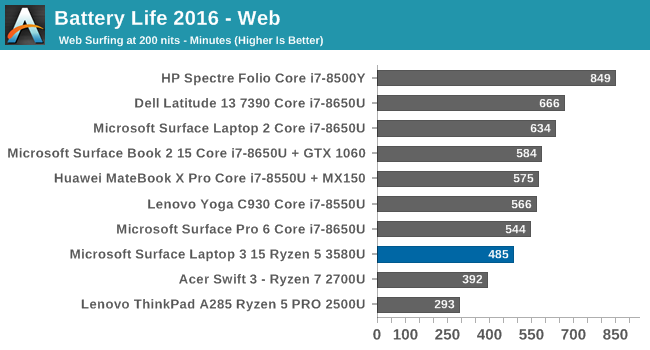
Our newer web test is much more CPU intensive, and a more realistic result than the older, lighter test. As expected, the results dropped further, to just over eight hours of usage, which is still a reasonable amount of time, but well under the 10.5 hours achieved by the Surface Laptop 2.
Movie Playback
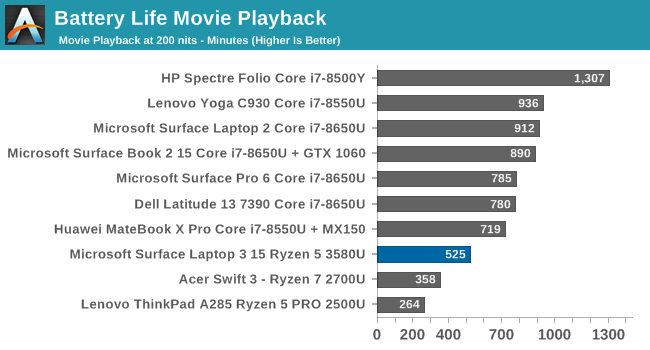
Video playback is one of Intel’s strengths, but it continues to be one of AMD’s weaknesses, with video playback time far shorter than the Intel offerings. Intel has put a lot of effort into offloading the video playback to fixed function hardware and turning the rest of the chip off, and while AMD certainly has hardware decode on their APU, it clearly can’t turn off the rest of the chip during playback, since the battery run time is somewhat less than our light web test.
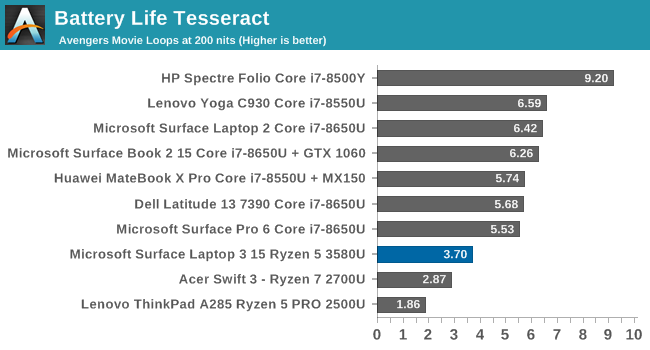
On the Tesseract score, the Surface Laptop 3 is still able to watch almost four entire sittings of The Avengers, which is a lot, but well under the 6.4 plays on the Surface Laptop 2.
Normalized Results
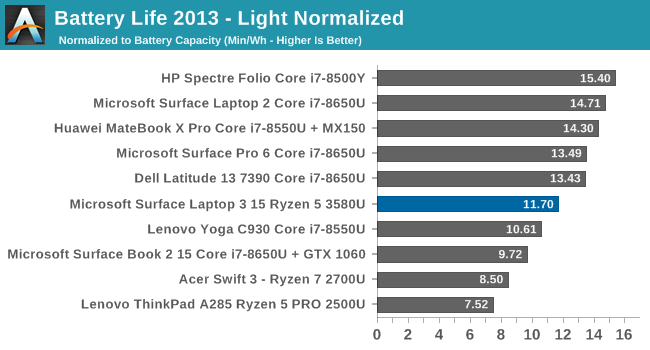
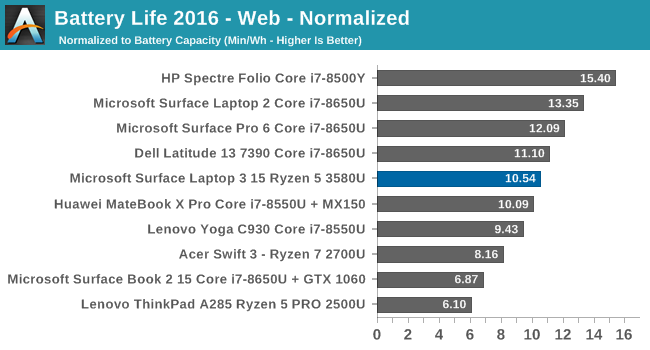
Removing the battery size from the runtimes lets us look at overall platform efficiency during the tests, and removes the insane runtime the Surface Book 2 provides thanks to its massive battery. Here the results are mixed. AMD has certainly made some tremendous strides in improving the abysmal platform power of the Ryzen APU from the original Raven Ridge to the current Picasso platform, with a much better showing in both the light test and 2016 Web results. Some of the discrepancy would come down to the display as well, since the larger 15-inch IGZO panel will need more power to light up to 200 nits than an equivalent 13.5-inch that we see in the Surface Laptop 2, but AMD definitely has more work to do in order to bring Ryzen's platform power down to what Intel has achieved.
The Acer Swift 3, which was the first Raven Ridge laptop we tested, drew 5.71 watts of power at idle with the display at 200 nits. That actually compares favorable with a Surface Book 2 15, which draws about the same – 5.53 Watts at idle with the display at 200 nits, but the main difference is the Surface Book 2’s display is the majority of the power draw thanks to its high resolution and 15-inch size. Removing display power from the devices results in the Acer Swift 3 drawing 4.55 watts at idle, and the Surface Book 2 drawing just 1.43 watts. The HP Spectre Folio, which features a Core i7 Y series processor, draws just 750 mW of power at idle.
The Surface Laptop 3 draws right around 5 Watts of power at idle with the display at 200 nits. That’s once again similar to the Surface Book 2 15, which draws 5.53 Watts. However, the Surface Laptop 3’s lower resolution display accounts for much less of the total platform draw. Removing the display from the equation results in the Surface Laptop 3 still drawing 2.35 Watts at idle. That’s significantly more than an Intel platform. So, while AMD has improved their battery draw tremendously, 2.35 Watts of idle power draw is still a lot and leads to the 15-inch Surface Laptop 3 delivering less battery life than the Surface Laptop 2, which was 8th generation Intel.
Charge Time
To make up for the less than amazing battery life of the Surface Laptop 3, Microsoft does include a stout 65-Watt charger which connects to the Surface Connect Port. All Surface power bricks also include an integrated USB-A output which is very handy when traveling if you need to charge your phone, although they may need to add USB-C soon.
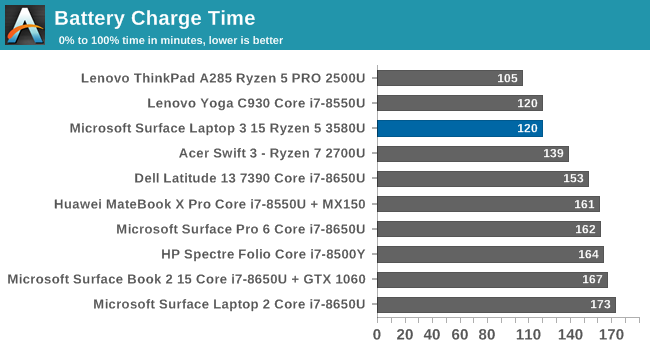
The Surface Laptop 3 charged very quickly. The smaller than average battery sized coupled with a larger than average adapter gave Microsoft lots of capacity to quickly get the Laptop 3 back up to a full charge.










91 Comments
View All Comments
andykins - Monday, October 21, 2019 - link
The Ice Lake Version is cheaper with a starting price of $999 compared with $1199 for the Ryzen version (admittedly this is a somewhat apples to oranges comparison as it is 13.5” vs 15”). This is in the table on the first page of the article.inighthawki - Monday, October 21, 2019 - link
There are 15" versions with an ice lake sold in the business store. They are $100 more for the same memory/HDD specs.Rickyxds - Monday, October 21, 2019 - link
Why you don't show the performance of UHD 630 in Rise of the Tomb Raider??Are you protecting Intel?... Why show the performance of the Ryzen and Vega in DOTA 2???
I answer to you, You are protecting Intel and UHD chips.
but I don't know why!
Brett Howse - Monday, October 21, 2019 - link
Ryan mentioned this on your other comment that was the same but they Intel iGPU is simply too slow to test on AAA games like this.Irata - Tuesday, October 22, 2019 - link
It may be worth mentioning this in the article or showing it in the graph as N/A.The really odd thing about the review is that the compared systems are not consistent across tests (i.e. 5 are included in some but not others).
Potato Power - Thursday, October 24, 2019 - link
They get pay-off by Intel. Simple.quadrivial - Monday, October 21, 2019 - link
> "The addition of an extra Vega core in the semi-custom Ryzen APU does help in some scenarios, but is still somewhat held back by the Zen CPU cores in real-world games."The GPU is probably held back by 2400MHz RAM, but it is DEFINITELY not held back by the CPU performance.
edzieba - Monday, October 21, 2019 - link
It's an integrated APU, both the CPU and GPU need to share the same thermal environment (and power environment). Any inefficiencies in the CPU have a knock-on effect on the GPU performance budget, and the choice in where the CPU/GPU split is placed also affects real-world performance.JasonMZW20 - Friday, October 25, 2019 - link
Ryzen will auto manage power between CPU/iGPU, so I don’t think that’s much of an issue. Memory bandwidth, though, has always been a limitation on AMD iGPUs. You can find benchmarks on desktop APUs with higher memory speeds and the gains associated with that.Problem is, if MS used DDR4-2933 that Zen+ officially supports, power consumption would increase on both SoC and memory, reducing overall battery life further.
skavi - Monday, October 21, 2019 - link
Do you guys have ice Lake Surface Laptops in your review pipeline? I would love to finally have an Apples to Apples comparison.